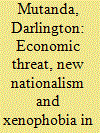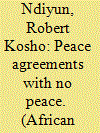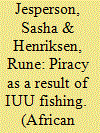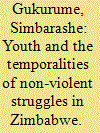|
|
|
Sort Order |
|
|
|
Items / Page
|
|
|
|
|
|
|
| Srl | Item |
| 1 |
ID:
187342


|
|
|
|
|
| Summary/Abstract |
The perceived economic threat has given rise to narrow nationalism in South Africa, which has given birth to direct, cultural and structural forms of violence, commonly referred to as xenophobia, which is actually Afrophobia. The main argument is that in as much as there is evidence of the influx of mainly African migrants in South Africa, and these have been largely accused of various crimes and contributing to rising unemployment, this perception trivialises the need for a multipronged and people-centred approach to South Africa’s and Africa’s underlying domestic challenges. Xenophobia should not be seen as only a South African but also an Africa problem, which consequently requires a national and continental response strategy. This then implies that South Africa has a role in stemming the challenges that have given impetus to a new form of narrow nationalism. On the other hand, the article attempts to explain what a continental response strategy might entail. In fact, the narratives of African migrants as pervasive criminals and job snatchers conveniently relieves the post-apartheid government which is expected to enhance service delivery and create opportunities for the locals, as well as giving dignity to the immigrants.
|
|
|
|
|
|
|
|
|
|
|
|
|
|
|
|
| 2 |
ID:
187336


|
|
|
|
|
| Summary/Abstract |
In this edition our authors remind us that although the scourge of organised crime and political violence remains part of societies in Africa, popular views are not always helpful when it comes to finding solutions for sustainable peace and security. For instance, one popular perception is that illicit and criminal activities are always linked to political opposition and insurgency; another is that immigrants are the cause of violent crime in society. Although we accept the evidence that shows a link between the drivers of insecurity such as crime, political resistance and illegal immigration, research shows that this is not always the case in all spaces. However, what does show a strong correlation is the link between government-driven peace initiatives with local ownership, non-governmental organisations and non-violent political movements that bring agency to the quest for assured, sustainable peace.
|
|
|
|
|
|
|
|
|
|
|
|
|
|
|
|
| 3 |
ID:
187340


|
|
|
|
|
| Summary/Abstract |
Societies faced with authoritarian rule or conflict usually adopt different paths to peace. The course adopted by each community to guarantee stability determines the extent to which the sustainability of the peace can be assured. Every attempt to pacify a society should aim to prevent a relapse to conflict or authoritarian rule while considering the damage caused and sorting out measures to repair the harm. The history of military coups and conflicts in the Central African Republic (CAR) is well documented. Still, the attempted remedies have greatly side-lined the raison d’être of the responses in guaranteeing peace and preventing relapse to conflict. As the CAR remains politically and socially unstable, an analysis of the failure of peace agreements to ensure stability constitutes a field of inquiry that urgently necessitates a more profound investigation to save the country from recurrent hostilities and guarantee a peaceful society for the citizens. Peace includes an aspiration manifested by both the CAR authorities and non-state armed groups in the course of hostilities and on the negotiation table. Central Africans indicate an interest in peace, but such interest often manifested and materialised in peace agreements has barely been implemented.
|
|
|
|
|
|
|
|
|
|
|
|
|
|
|
|
| 4 |
ID:
187337


|
|
|
|
|
| Summary/Abstract |
With declining global fish stocks, there is a growing literature on the negative impact of illegal, unreported and unregulated (IUU) fishing. While undoubtedly damaging, there is increasing analysis on the wider impact of IUU fishing, without sufficient evidence to support causal claims. This is particularly evident in the links between IUU fishing and piracy. IUU fishing was blamed for the surge of piracy in the Gulf of Aden in in the late 1990s/ early 2000s and is more recently presented as a driver for piracy in the Gulf of Guinea. In reviewing available evidence, this article finds that while there is a correlation between IUU fishing and piracy in the Gulf of Guinea, in that they both occur in the same areas, current evidence does not support a causal link between the two.
|
|
|
|
|
|
|
|
|
|
|
|
|
|
|
|
| 5 |
ID:
187341


|
|
|
|
|
| Summary/Abstract |
Using the current conflict in northern Mozambique as a case study, we argue that the South African government and its current legislation on private military and security companies (PMSCs) has prevented it from being a more effective agent for peace in the region. South Africa’s current legislation – the Foreign Military Assistance Act of 1998 (FMA) and the Prohibition of Mercenary Activities Act of 2006 (PMA) – creates a situation, a deliberate and intentional one, where PMSCs are unable to operate effectively effectively. Therefore PMSCs do not operate from South Africa, despite South African PMSCs being well regarded and experienced internationally. The FMA and PMA also oppose a general international trend which is seeing increased use and acceptance of PMSCs. We argue that the conflict in northern Mozambique is an example where legislation which is more accepting of the PMSC industry would have allowed South Africa to provide more (and earlier) assistance to Mozambique. This would have helped Mozambique and the region, but, importantly, it would also have been a valuable tool in South Africa’s foreign diplomacy and projected the potential for the use of smart power.
|
|
|
|
|
|
|
|
|
|
|
|
|
|
|
|
| 6 |
ID:
187339


|
|
|
|
|
| Summary/Abstract |
Youth in fragile and conflict-ridden spaces are often constructed as violent and restless subjects who dismember the social fabric of society. Yet, many young people are using non-violent tactics and strategies to articulate their grievances and frustrations with the state of their economies. Young people in such decaying economies live under precarious and uncertain existential conditions. Drawing on the #ThisFlag movement in Zimbabwe, this article sheds light on the complex temporalities of non-violent resistance in post-colonial Africa and the place of social media in creating new and alternative forms of protest. The article examines the ways in which young people mobilising under the #ThisFlag movement deployed cyberspaces to launch concerted non-violent resistance against the Mugabe and Mnangagwa regimes. It also discusses various non-violent tactics the #ThisFlag movement deployed to tactically navigate the precarious terrain of political activism. I argue that young people instrumentalised their techno-savviness to mass-mobilise and enact novel and defiant forms of non-violent political action which posed a serious threat to ZANU-PF’s durable political hegemony. I also argue that #ThisFlag’s use of non-violent resistance should be understood as an exercise of agency and social navigation in a context of protracted violence against government critics and opposition political activists.
|
|
|
|
|
|
|
|
|
|
|
|
|
|
|
|
| 7 |
ID:
187338


|
|
|
|
|
| Summary/Abstract |
The National Peace and Reconciliation Commission (NPRC) in Zimbabwe is potentially a crucial architect of coordinated and integrated infrastructure for peace (I4P). But it is not without its critics and sceptics. The Commission is the institutional centrepiece of government’s post-conflict justice, peace, healing and reconciliation programme. It is mandated with developing national and sub-national architecture to drive the peacebuilding agenda. The NPRC is relatively young and is in the process of emplacing structures to acquire the organisational capacity to execute its mandate efficaciously within major constraints. While statist, top-down approaches are hardly sufficient to build peace, the Commission is evolving into a broad peace infrastructure, weaving horizontal and vertical relationships with various local stakeholders with the assistance of international partners. The NPRC is leading Zimbabwe’s I4P project in a context-specific manner that promotes the principles of national and local ownership, inclusivity, gender mainstreaming, cooperation and capacity building for sustainability. The Commission, notwithstanding its well-documented weaknesses, has achieved important milestones towards a prospective integrated national I4P. This article broadens the existing literature on the NPRC by examining milestones in the implementation of its mandate, particularly demonstrating how it is morphing into a potential cornerstone of a broad national I4P with external support.
|
|
|
|
|
|
|
|
|
|
|
|
|
|
|
|
|
|
|
|
|